|
Osama bin Laden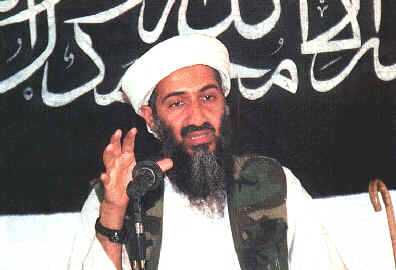 It's not what you know, but who you know. And Osama bin Laden knows all the wrong people.
It's not what you know, but who you know. And Osama bin Laden knows all the wrong people.
Osama bin Laden was born in 1957 and developed a bad case of "middle-child syndrome" -- he was the 17th of 52 children. I think we all know how difficult that can be. But while Jan Brady contented herself with agonizing over "Marcia, Marcia, Marcia," bin Laden decided on a much larger target for his rage — the entire world. Osama bin Laden's terrorist networking organization al Qaeda has unified a diverse collection of smaller extremist groups into a worldwide coalition responsible for tens of thousands of deaths over the last decade. His war on America culminated in the September 11 attack on America which destroyed the twin towers of the World Trade Center and made the world's arch-terrorist into a household name.
Where it all beganbin Laden's father, according to al Qaeda propaganda, was a poor laborer in Jeddah, Saudi Arabia, who bootstrapped his way to become the partiarch the second-richest family in the oil-rich country -- second only to the royal family. According to the propagandists, bin Laden Sr. imposed tough discipline on his children and insisted they follow strict Muslim practices. "He was very keen not to show any difference in the treatment of his children," adds the tract (published by PBS Frontline), which is a pretty good trick when you have 52 kids.Young Osama graduated from a Jeddah university in 1979 with a degree in civil engineering. Naturally, this training inspired him to become a freelance warmonger. The chic venue at the time was Afghanistan, which the Soviet Union had invaded in 1978. With the support of the Saudi and U.S. governments, bin Laden took up the struggle of the mujahideen rebels who were working to repel the Soviets. bin Laden used his personal fortune and connections to raise funds for the mujahideen, providing aid with logistics, supplies and "humanitarian" aid. He took part in fighting, by all accounts fearless and focused in working to fortify mujahideen positions. He also helped recruit Muslims for the battle from a headquarters in neighboring Pakistan. As with so many of America's worst nightmares, bin Laden and his cronies received financial support and training from the CIA during this period. The CIA had come up with this fabulous notion that it could incite the entire Arab world into jihad against the godless Soviets. It looked great on paper! What could possibly go wrong? President Ronald Reagan authorized the covert release of funds, high-end armaments and CIA "specialists" to assist the mujahideen in driving the Soviets out of Afghanistan, an effort that ultimately succeeded in 1989. Working with Sheikh Abdullah Azzam during the mid-1980s, bin Laden had helped establish the "Office of Services," a support organization for the mujahideen, led by Azzam. As the Soviets found themselves increasingly on the defensive, Afghanistan became a fait accompli, and bin Laden found himself a warmonger without a war to mong. Being a self-starter, it wouldn't take him long to rectify that situation. Azzam didn't share bin Laden's sweeping ambitions, but a convenient car bomb in 1989 left bin Laden the heir apparent for an army of Arab mujahideen, volunteer fighters who'd developed a taste for the service of Allah, which in their minority view primarily involved killing infidels. Building from the Base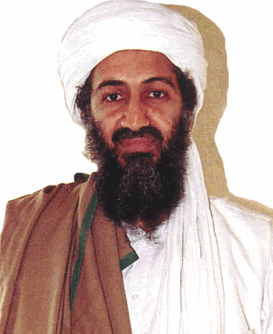 The roots of bin Laden's brand of extremist Islam actually date back to the Crusades of the 12th century. "bin Laden's Islam" interprets the religion in the most violent and confrontational terms. In this context, jihad is a mandate to use force in the service of Allah. "to further the rule of Islam over contested lands," currently defined as any land ever occupied by Muslims, according to author and bin Laden expert Yossef Bodansky.
The roots of bin Laden's brand of extremist Islam actually date back to the Crusades of the 12th century. "bin Laden's Islam" interprets the religion in the most violent and confrontational terms. In this context, jihad is a mandate to use force in the service of Allah. "to further the rule of Islam over contested lands," currently defined as any land ever occupied by Muslims, according to author and bin Laden expert Yossef Bodansky.
The intensity of the battle in Afghanistan had created a significant power base for militant Islamic fundamentalists, consisting of battle-tested Arab mujahideen soldiers and an infrastructure for the movement of money, arms and personnel through central offices in the Middle East, Afghanistan and Pakistan. In 1988, bin Laden and about 40 confederates formed al Qaeda, a name which translates as "The Base." al Qaeda's propaganda claims the group was formed to provide information to concerned families of Arab mujahideen. What a bunch of sweethearts! The historical record differs slightly. According to most accounts, the members met in Pakistan and pledged a blood oath to support the jihad in Afghanistan. But 1988 was a bit late for such histrionics. With the Soviets in full retreat from Afghanistan just one year later, Osama bin Laden found himself in possession of a sworn and battle-tested army, a significant personal fortune and plenty of power and influence. All he lacked was an enemy. bin Laden had no great love for Saddam Hussein, the secular dictator of Iraq, whom he and others considered a bad Muslim. But when U.S. forces swept into the region to repel Iraq's invasion of Kuwait, bin Laden found the overt cause he lacked. At first, bin Laden responded to the invasion with an offer to deploy his mujahideen in defense of Saudi Arabia, but he was spurned in favor of an armed assist from George HW Bush. "Marcia, Marcia, Marcia!" Snubbed as a second-rate warlord by his own country, bin Laden became a noisy political opponent of the alliance with the United States, which he characterized as a U.S. agenda to permanently establish a military foothold in the Persian Gulf. bin Laden's incessant bitching initially led the Saudis to arrest him. But because of his popular support, which crossed international borders and social strata, the prospect of a lengthy prison term was a public relations nightmare for the Saudi regime. bin Laden was allowed to flee the country with a wink and a nod in 1991. With the support of other wealthy and influential Saudis, bin Laden began setting up operations in Afghanistan, Southeast Asia and the Sudan. From the Sudan, bin Laden began actively working against the United States, starting no later than 1992. His stated goal was to drive U.S. forces out of the Persian Gulf. His preferred means for accomplishing that goal would be terrorism, specifically the unification of a diverse group of ragtag terrorist cabals into a global network. Coming to America With the U.S. now fixated in bin Laden's mind as the enemy, al Qaeda began a dramatic expansion throughout the world. Using a network of financial shell companies and fake charities such as the Benevolence International Foundation, he sent mujahideen, family friends and relatives to hotspots such as Southeast Asia and Africa. The impoverished Sudan basically turned over the keys of the country to bin Laden in exchange for which he spent millions building the nation's infrastructure and moving huge sums through local banks and businesses he controlled.
With the U.S. now fixated in bin Laden's mind as the enemy, al Qaeda began a dramatic expansion throughout the world. Using a network of financial shell companies and fake charities such as the Benevolence International Foundation, he sent mujahideen, family friends and relatives to hotspots such as Southeast Asia and Africa. The impoverished Sudan basically turned over the keys of the country to bin Laden in exchange for which he spent millions building the nation's infrastructure and moving huge sums through local banks and businesses he controlled.
Other agents moved to Europe and the United States. By the early 1990s, al Qaeda operatives and allied terrorists had set up shop and were running money and arms through U.S. cities such as Chicago, Houston, Kansas City, Santa Clara and Fort Lauderdale. In 1992, al Qaeda fired the first formal shots in the war on America, targeting American soldiers with a bomb in Yemen. It wasn't exactly a glorious victory. The soldiers had left the targeted hotel two days earlier on a humanitarian mission to Somalia. Two Austrian tourists took the hit instead. Wisely, bin Laden chose to distance himself from this fuck-up. According to a propaganda document given to PBS Frontline: "During (bin Laden's) stay in Sudan anti-American incidents happened in Somalia and South Yemen. Neither of the two incidents was performed by his group in the proper sense of chain of command. Both were performed by people who had training in Afghanistan and had enough anti-American drive. He might have given some sanctioning to the operations but one thing was certain, the Sudanese were completely unaware of either." Despite this tepid non-denial denial, most scholars agree the Yemen attack was the first official act of terror by al Qaeda. It might have been lame, but bin Laden and his minions were nothing if not quick learners. Reign of Terror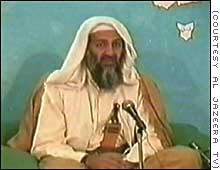 The pace of bin Laden's attacks on America picked up rapidly in the years that followed, and his aim improved considerably. In 1993, Ramzi Yousef bombed the World Trade Center, working with members of another terrorist group ensconced in New York, Islamic Jihad, a radical extremist organization with branches in Palestinian territories and Egypt. Evidence suggests that bin Laden was behind the 1993 attack. Yousef had trained with the mujahideen in Afghanistan, and his uncle Khalid Shaikh Mohammed helped support the attack by wiring money to the bomber (at minimum). Khalid would later rise to the No. 3 position in al Qaeda.
The pace of bin Laden's attacks on America picked up rapidly in the years that followed, and his aim improved considerably. In 1993, Ramzi Yousef bombed the World Trade Center, working with members of another terrorist group ensconced in New York, Islamic Jihad, a radical extremist organization with branches in Palestinian territories and Egypt. Evidence suggests that bin Laden was behind the 1993 attack. Yousef had trained with the mujahideen in Afghanistan, and his uncle Khalid Shaikh Mohammed helped support the attack by wiring money to the bomber (at minimum). Khalid would later rise to the No. 3 position in al Qaeda.
bin Laden recruited another top deputy from Islamic Jihad, Ayman Al-Zawahiri. Zawahiri was a surgeon who had been fighting for extremist causes since the age of 15. As leader of the Egyptian Islamic Jihad, Zawahiri had been involved with numerous attacks on the Egyptian government prior to his alliance with bin Laden, including the assassination of Anwar Sadat. Zawahiri is considered al Qaeda's operational coordinator, the CEO to bin Laden's Chairman of the Board. With Zawahiri in tow, bin Laden's al Qaeda absorbed much of Islamic Jihad's staff and resources. The precedent also helped establish Qaeda's role as a conglomerate of terror organizations. Other organizations soon followed Zawahiri's lead and joined the fold, either formally or informally, including Abu Sayyaf, Jemaah Islamiah, Hezbollah, Hamas and dozens of others. The support bin Laden offered these often diverse groups primarily fell into three areas, financing, training and arms. bin Laden's deep pockets provided a base to begin with, which was supplemented by wealthy Saudi patrons and various charity rip-offs that misdirected funds raised under charitable guise to mujahideen in Chechnya, at times directly funding terrorist attacks. Said attacks continued, including the bombing of U.S. embassies in Africa, the attack on the U.S.S. Cole, attempts to assassinate the pope and then-President Clinton, and an early attempt to stage a Sept. 11-style attack out of the Philippines, where bin Laden's brother-in-law Mohammed Jamal Khalifa had been funding operations on behalf of al Qaeda. More than a Technicality, Less than a Papacy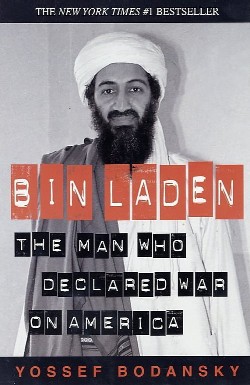 The heat began to stick to bin Laden, and in spring 1996, President Bill Clinton signed an executive order authorizing the CIA to destroy bin Laden's network through any available means, and later that year, a secret grand jury began investigating his activities.
The heat began to stick to bin Laden, and in spring 1996, President Bill Clinton signed an executive order authorizing the CIA to destroy bin Laden's network through any available means, and later that year, a secret grand jury began investigating his activities.
In May, the Sudan expelled bin Laden, under heavy pressure from the Saudis. But bin Laden wrested a powerful victory from this seeming defeat, in a development little noted by Western observers, who may have seen it as a technicality. Osama bin Laden relocated to Afghanistan after his expulsion. Once ensconced there, according to Bodansky, bin Laden set up a territorial network of camps and training compounds, with the support of the ruling Taliban party. By establishing his rule over a territorial boundary, Osama bin Laden was able to claim an Imarat or emirate, which under Islamic law gave him a special dispensation to act as a teacher of Islam without a formal religious education. From a Western perspective, this may have seemed like a meaningless honorific. After all, Bill Cosby has an honorary doctorate, but he doesn't perform liver transplants. But the Western perspective hardly mattered to bin Laden's prospective followers. With his ascendence to emir status, bin Laden would be addressed by the quasi-religious title Sheikh. The legitimacy of bin Laden's claim to religious authority is somewhat contentious in a global context, but the new title gave militant Islamic fundamentalists the necessary pretext to embrace a message they already wanted to hear. The move fundamentally changed bin Laden from a itinerant military commander to landed religious nobility, and he wasted no time exploiting this new status. In August 1996, bin Laden formally threw his newfound authority behind the cause which had already occupied him for several years — he issued a fatwa declaring jihad against the United States. He outlined specific goals, including the expulsion of U.S. forces from the Persian Gulf and the overthrow of the Saudi regime. The direct attack on the U.S. represented a major escalation of the militant Islamic agenda, which had previously focused on Israel and regional issues. The attacks continued. In 1998, a grand jury in New York issued a sealed indictment against bin Laden. Later that year, the U.S. launched air strikes against al Qaeda camps in Afghanistan. He moved to the top of the FBI's "Most Wanted Terrorist" list. But it wasn't until Sept. 11, 2001 that the effort to catch bin Laden become a national crusade. Marked Man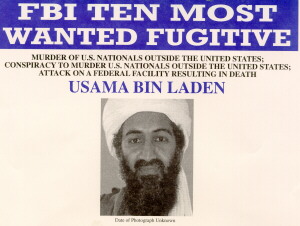 On Sept. 11, 2001, al Qaeda hijacked two jets and crashed them into the twin towers of the World Trade Center, demolishing both towers. A third hijacked jet was crashed into the Pentagon, severely damaging the structure. On a fourth plane, targeted for the White House, the passengers rose up and overcame the hijackers, after being informed of the previous crashes via cell phone calls to loved ones. The plane crashed in rural Pennsylvania.
On Sept. 11, 2001, al Qaeda hijacked two jets and crashed them into the twin towers of the World Trade Center, demolishing both towers. A third hijacked jet was crashed into the Pentagon, severely damaging the structure. On a fourth plane, targeted for the White House, the passengers rose up and overcame the hijackers, after being informed of the previous crashes via cell phone calls to loved ones. The plane crashed in rural Pennsylvania.
Within hours of the attack, Osama bin Laden was the prime suspect. Experts said only al Qaeda had the organization and ingenuity of the attack. Some remembered an earlier plot, hatched in the Philippines by Khalid Shaikh Mohammed, which proposed using commercial planes as suicide bombs. Retribution was swift. President George W Bush vowed to "bring the terrorists to justice, or bring justice to the terrorists." In pursuit of the latter goal, the U.S. demanded that Afghanistan's Islamic fundamentalist regime, the Taliban, turn bin Laden over for prosecution. The Taliban refused, and by spring 2002, they had been destroyed by U.S. air power and a native insurgent group called the Northern Alliance. U.S. attacks specifically targeted al Qaeda camps and strongholds in an effort to kill bin Laden, but he apparently survived the onslaught, releasing sporadic messages on audio and video tape, just in case anyone had any doubts.
But after one of the CIA's aerial assassination robots scored a near miss on Zawahiri in early 2006, bin Laden emerged to reassert himself with an audio message, offering a "truce" to the U.S. -- on the condition that America pulls its forces out of Afghanistan and Iraq. The offer was a transparent formality for the benefit of Islamic listeners -- he readily conceded in the message that unclean pigs would fly before Bush would give up his Middle Eastern ambitions. But proper Islamic ettiquette required him to make the offer. Underlining the purely symbolic nature of the truce offering, bin Laden warned that new attacks were already underway in the U.S. Ever since the U.S. invaded Afghanistan, experts have been repeating, dronelike, a small set of tired speculations about the master terrorist's fate -- he's sick (debateable), he's lost control of al Qaeda (debateable), he's dead (clearly untrue). As Mohammed Jamal Khalifa drily observed in an interview with CNN, "If Osama was dead, everyone would know." At its heart, after all, al Qaeda is a cult that glorifies death. A dead bin Laden is good for considerably more mileage than a living, but incommunicado, bin Laden. And a dead man can't ever disappoint you again. As for his location, the dronelike experts also have a standard refrain -- he is somewhere in the wild mountainous border between Afghanistan and Pakistan. This is akin to saying he's somewhere in the Amazon jungle -- it's descriptive but not terribly helpful if you actually want to find someone. Slightly better informed experts believe bin Laden that he may be in Iran, where other key al Qaeda members, including Osama's son, have been hanging their turbans. Ultimately, all this speculation is pretty darn speculative. Until Task Force 121 hears the wailing in the distance -- "Marcia, Marcia, Marcia!" -- Osama bin Laden's location will remain the world's best kept secret. And don't worry -- when he's dead, everyone will know. Just listen for the explosions.
Timeline
|
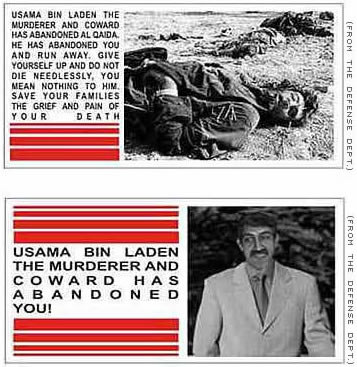 The Taliban refused, and by spring 2002, they had been destroyed by U.S. air power and a native insurgent group called the Northern Alliance. U.S. attacks specifically targeted al Qaeda camps and strongholds in an effort to kill bin Laden, but he survived the onslaught, releasing sporadic messages on audio and video tape, just in case anyone had any doubts.
As the U.S. set up shop in Iraq in 2003, bin Laden began to be marginalized by more radical elements in al Qaeda, such as Zawahiri and the fast-rising star of
The Taliban refused, and by spring 2002, they had been destroyed by U.S. air power and a native insurgent group called the Northern Alliance. U.S. attacks specifically targeted al Qaeda camps and strongholds in an effort to kill bin Laden, but he survived the onslaught, releasing sporadic messages on audio and video tape, just in case anyone had any doubts.
As the U.S. set up shop in Iraq in 2003, bin Laden began to be marginalized by more radical elements in al Qaeda, such as Zawahiri and the fast-rising star of